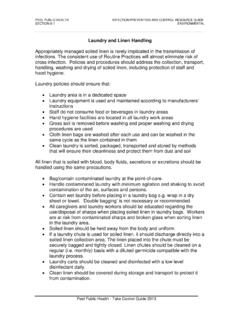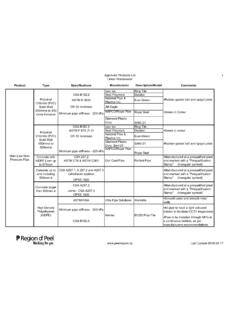Transcription of Food Handler Certification - Peel; Region
1 food Handler Certification study guide Welcome to the food Handler Certification study guide ! Welcome to the food Handler Certification study guide ! Welcome to the food Handler Certification study guide ! Welcome to the food Handler Certification study guide ! In this guide , you will learn about safe food handling practices and prepare for the food Handler Certification Exam. Learning safe food handling practices will help you to protect yourself and others from becoming sick from food or drink and will give you valuable job skills for the food service industry. After passing the exam, you will receive a food Handler Certificate that is valid for five years. How to Use this study guide We highly recommend that you read all the chapters and answer the study questions at the end of each chapter to test your knowledge. The answers to the study questions and a list of definitions can be found at the back of the study guide .
2 Pay special attention to the Chapter Review sections as well as the information boxes, such as the one at the bottom of this page. You can choose to prepare for the exam by studying this guide and either taking the food Handler Full Day Class offered by the Region of peel , or studying at home before you take the exam. Both options are described below. 1. food Handler Full Day Class In the class, instructors will review the information in the study guide and answer any questions you have about safe food handling. You will also watch videos and participate in activities. Before you come to the class, we recommend that you read the study guide and answer the study questions at the end of each chapter. The Certification exam will take place at the end of the class. 2. Home study This study guide has all the information you need to successfully pass the exam. If you are studying the guide on your own, you must call the Region of peel at 905-799-7700 to book an appointment for the food Handler Certification Home study Exam.
3 The Exam The exam consists of 50 questions with multiple choice answers. To pass the course you will need to answer at least 35 out of 50 questions correctly (70%). Take your time learning the information and enjoy! Remember! If you have any questions regarding the food Handler Certificate course or exam, call the Region of peel at 905-799-7700 and speak to a Public Health Inspector. Table of ContentsTable of ContentsTable of ContentsTable of Contents Introduction to Foodborne Chapter 1 Public Health Laws and the food Chapter2 Micro-organisms in Chapter 3 food Chapter 4 Understanding Foodborne Illness & Chapter 5 Wash, Rinse and Sanitize ..56 Chapter 6 Flow of Chapter 7 HACCP: A System to Keep food Chapter 8 Taking Care of a food Premises ..94 Chapter 9 Pest Answers to Exercises and study Appendices Appendix A Where to Find Ontario Appendix B Temperature Appendix C Common Foodborne Illness Appendix D Correct Handwashing Procedure Poster.
4 122 Appendix E Wash, Rinse and Sanitize in a Three-Compartment Sink Poster ..123 Appendix F Wash, Rinse and Sanitize in a Two-Compartment Sink Appendix G How to Safely Make a Salad ..125 Appendix H 7 Steps of a HACCP Plan ..126 Did you In 2011, there were over 800 cases of foodborne illness in the Region of peel , and many more cases were never reported. In fact, it is estimated that one in ten people who live in peel Region experiences a foodborne illness every year. Introduction to Foodborne Illness Introduction to Foodborne Illness Introduction to Foodborne Illness Introduction to Foodborne Illness Foodborne illness, also known as food poisoning, is what happens when a person becomes sick after eating food or drinking a beverage that is unsafe. Learning how to safely handle food is important because your actions can prevent foodborne illness. Most foodborne illnesses are caused by bacteria that you cannot see, smell, or taste.
5 By understanding how to prevent bacteria from growing and using safe food handling practices that are presented in this guide , you can protect your customers and yourself. People with a foodborne illness can have: nausea vomiting diarrhea abdominal pain headache fever dehydration Most people with a foodborne illness get better quickly, but in some cases there can be long-term problems and even death. Seniors, young children, pregnant women and people with weak immune systems are most likely to become very sick. Everyone involved in the food industry has a role to play in making sure the food we eat is safe. This guide describes your roles and responsibilities as a food Handler and all the information you need to become a safe and certified food Handler . Chapter 1 Public Health Laws and the food Handler Public Health LPublic Health LPublic Health LPublic Health Lawsawsawsaws In Ontario, there are three different types of law that protect our health; Acts, Regulations and By-laws.
6 These are described below. 1. An Act is a law that describes who is in charge and what their responsibilities are to take care of the public. The Health Protection and Promotion Act is a provincial law for Ontario. This Act gives food premises operators the responsibility to follow the standards in the food Premises Regulation. It also gives local health departments and Public Health Inspectors the responsibility to inspect food premises to make sure the standards are being met. food premises are places that serve food to the public including restaurants, food take-outs, cafeterias, grocery stores, daycares, hospitals, nursing homes, and homes for the elderly. 2. A Regulation is a part of an Act that describes specific standards that need to be followed. The food Premises Regulation (Ontario Reg. 562) is a provincial law under the Health Protection and Promotion Act. This regulation explains the minimum health standards for all food premises in Ontario.
7 An example of one of the food Premises Regulation standards is that hazardous food in a refrigerator must be stored at 4 C (40 F) or colder. Remember! food handlers must follow these standards while Public Health Inspectors make sure the standards are being met when doing their inspections. Some pages have been removed from this book preview. Chapter 2 Micro-organisms in food Micro means very small Organism means life form Pathogen means harmful micro-organism MicroMicroMicroMicro----organisms Cause Foodborne Illnessorganisms Cause Foodborne Illnessorganisms Cause Foodborne Illnessorganisms Cause Foodborne Illness Foodborne illness is caused by harmful things that get into food (or drink), making it unsafe. These harmful things are also known as contaminants. This chapter will focus on the biological (living) contaminants that cause food to become unsafe.
8 What are micro-organisms? Micro-organisms are very small living things and can be safe or harmful for our health. Safe micro-organisms are an important part of making food such as yogurt, beer, cheese and bread. These micro-organisms are safe to eat. Harmful micro-organisms are called pathogens. Pathogens are not safe to eat, and can cause someone to become sick. Some examples of pathogens include: Salmonella bacteria, Hepatitis A virus and Giardia parasite. Where are pathogens found? Raw food such as meat, poultry and fish Unclean food preparation equipment such as mixers, slicers, blenders, can openers, spoons, knives, pots, pans, tables, cutting boards and gloves People, especially a person s hands, nose, mouth and bodily wastes (feces and urine) Insects such as cockroaches and flies Rodents such as mice and rats Polluted air, soil and water FFFFour our our our Types of MiTypes of MiTypes of MiTypes of Microcrocrocro----OrganismsOrganismsOrga nismsOrganisms There are four types of micro-organisms that cause foodborne illness.
9 1. BacteriaBacteriaBacteriaBacteria Bacteria cause most foodborne illnesses in Canada. You cannot see, smell or taste bacteria, which makes it difficult to know whether your food has been contaminated (made unsafe). When heated to a temperature of 74 C (165 F) or hotter, bacteria will die. For more information on how temperature affects bacteria, see page 22. Examples of bacteria that cause foodborne illness include Salmonella, Campylobacter and E. coli. Picture of bacteria 2. VirusesVirusesVirusesViruses Viruses are the smallest type of microorganism. They can be found in water, ice, raw fish and raw unwashed fruits and vegetables that have come in contact with animal or human feces. Viruses are most likely spread by a food Handler who is infected with the virus and/or has poor personal cleanliness. Examples of viruses that cause foodborne illness include Hepatitis A and Norovirus.
10 Picture of a virus Some pages have been removed from this book preview. Chapter 3 food Contamination The food Handler Who Worked While Sick The owner of a small business with 3 different locations ordered lunch for all of the staff every Saturday. One Sunday, all of his staff became sick with vomiting and diarrhea. Even though his staff worked in three different places, they had all eaten food from the same restaurant. A Public Health Inspector was called to investigate and found that the staff were all sick with Norovirus and that a line cook at the restaurant was sick with vomiting and diarrhea a couple of days earlier. The cook said he felt fine on Saturday and returned to work. To prevent contaminating food when sick, the Public Health Inspector informed the staff that they should stay away from handling food until the symptoms are gone for at least 24 hours before returning to work.









